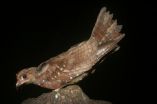(Press-News.org) The H5N1 bird flu virus has infected and killed hundreds of people, despite the fact that, at the moment, the virus can't spread easily between people. The death toll could become much worse if the virus became airborne. A study published by Cell Press April 10th in the journal Cell has revealed a minimal set of mutations allowing H5N1 to be transmitted through the air from one ferret to another. The findings will be invaluable for future surveillance programs and may provide early warning signals of the emergence of potential pandemic strains.
"By gaining fundamental knowledge about how the influenza virus adapts to mammals and becomes airborne, we may ultimately be able to identify viruses that pose a public health risk among the large number of influenza viruses that are circulating in animals," says senior study author Ron Fouchier of Erasmus Medical Center. "If we can do this, we might be able to prevent some pandemics in the future."
The H5N1 virus has caused serious outbreaks in domestic poultry in Asia and the Middle East and has infected people in 15 countries. The virus must be transmissible through air for a pandemic to occur, and Fouchier and his colleagues previously identified several H5N1 mutations linked to airborne transmission through aerosol or respiratory droplets. But, until now, the minimal set of mutations required for airborne transmission was not clear, hindering the ability of scientists to predict and prepare for pandemics.
In the new study, the researchers identified five mutations that are sufficient for airborne transmission of H5N1 between ferrets—one of the best models of influenza transmissibility available today. Two mutations improved the binding of the virus to cells in the upper respiratory tract of mammals; two other mutations enabled the virus to replicate more efficiently; and the remaining mutation increased the stability of the virus.
"This type of analysis provides a more complete picture of the changes that may constitute increased risk of H5N1 transmissibility," says Peter Palese of the Icahn School of Medicine at Mount Sinai, who coauthored an Essay accompanying the research paper. "Assessment of how adaptations in ferrets affect viral fitness, virulence, and transmission is sorely needed in order to gain a truly holistic perspective of the likelihood that these viruses might cause a pandemic and what characteristics such a pandemic might exhibit."
INFORMATION:
Cell, Linster et al.: "Identification, Characterization, and Natural Selection of Mutations Driving Airborne Transmission of A/H5N1 virus."
Insights into how a bird flu virus spreads could prevent pandemics
2014-04-10
ELSE PRESS RELEASES FROM THIS DATE:
Genetic distinctness to guide global bird conservation
2014-04-10
In the midst of today's global extinction crisis, decisions about conservation should include prioritizing how best to preserve as much of the tree of life as possible. So say researchers who report in the Cell Press journal Current Biology on the first application of an approach to identify the most evolutionarily distinct of the world's 9,993 bird species.
At the very top of their list of the most evolutionary distinct birds is the South American oilbird, which represents almost 80 million years of evolution shared with no other bird on the planet.
"Evolutionary distinctness ...
Researchers find that influenza has an Achilles' heel
2014-04-10
Flu epidemics cause up to half a million deaths worldwide each year, and emerging strains continually threaten to spread to humans and cause even deadlier pandemics. A study published by Cell Press on April 10 in the journal Immunity reveals that a drug that inhibits a molecule called prostaglandin E2 (PGE2) increases survival rates in mice infected with a lethal dose of the H1N1 flu virus. The findings pave the way for an urgently needed therapy that is highly effective against the flu virus and potentially other viral infections.
"Drugs that specifically target PGE2 ...
Team solves decades-old mystery of how cells keep from bursting
2014-04-10
LA JOLLA, CA—April 10, 2014—A team led by scientists at The Scripps Research Institute (TSRI) has identified a long-sought protein that facilitates one of the most basic functions of cells: regulating their volume to keep from swelling excessively.
The identification of the protein, dubbed SWELL1, solves a decades-long mystery of cell biology and points to further discoveries about its roles in health and disease—including a serious immune deficiency that appears to result from its improper function.
"Knowing the identity of this protein and its gene opens up a broad ...
Lactate metabolism target halts growth in lung cancer model
2014-04-10
BOSTON – Cancer cells generate energy differently than normal cells, a characteristic that helps them to survive and metastasize. A major goal in the field of cancer metabolism is to find ways to overcome this survival advantage.
Now a research team led by investigators in the Cancer Center at Beth Israel Deaconess Medical Center (BIDMC) has found that targeting the enzyme responsible for the final step of glucose metabolism not only halts tumor growth in non-small-cell lung cancer, but actually leads to the regression of established tumors.
Importantly, the new findings, ...
Getting to the root of Parkinson's disease
2014-04-10
Working with human neurons and fruit flies, researchers at Johns Hopkins have identified and then shut down a biological process that appears to trigger a particular form of Parkinson's disease present in a large number of patients. A report on the study, in the April 10 issue of the journal Cell, could lead to new treatments for this disorder.
"Drugs such as L-dopa can, for a time, manage symptoms of Parkinson's disease, but as the disease worsens, tremors give way to immobility and, in some cases, to dementia. Even with good treatment, the disease marches on," says ...
Too much protein may kill brain cells as Parkinson's progresses
2014-04-10
Scientists may have discovered how the most common genetic cause of Parkinson's disease destroys brain cells and devastates many patients worldwide. The study was partially funded by the National Institutes of Health's National Institute of Neurological Disorders and Stroke (NINDS); the results may help scientists develop new therapies.
"This may be a major discovery for Parkinson's disease patients," said Ted Dawson, M.D., Ph.D., director of the Johns Hopkins University (JHU) Morris K. Udall Center of Excellence for Parkinson's Disease, Baltimore, MD. Dr. Dawson and ...
Researchers determine how mechanical forces affect T-cell recognition and signaling
2014-04-10
T-cells are the body's sentinels, patrolling every corner of the body in search of foreign threats such as bacteria and viruses. Receptor molecules on the T-cells identify invaders by recognizing their specific antigens, helping the T-cells discriminate attackers from the body's own cells. When they recognize a threat, the T-cells signal other parts of the immune system to confront the invader.
These T-cells use a complex process to recognize the foreign pathogens and diseased cells. In a paper published this week in the journal Cell, researchers add a new level of understanding ...
Researchers identify transcription factors distinguishing glioblastoma stem cells
2014-04-10
The activity of four transcription factors – proteins that regulate the expression of other genes – appears to distinguish the small proportion of glioblastoma cells responsible for the aggressiveness and treatment resistance of the deadly brain tumor. The findings by a team of Massachusetts General Hospital (MGH) investigators, which will be published in the April 24 issue of Cell and are receiving advance online release, support the importance of epigenetics – processes controlling whether or not genes are expressed – in cancer pathology and identify molecular circuits ...
Yale researchers search for earliest roots of psychiatric disorders
2014-04-10
Newborns whose mothers were exposed during pregnancy to any one of a variety of environmental stressors — such as trauma, illness, and alcohol or drug abuse — become susceptible to various psychiatric disorders that frequently arise later in life. However, it has been unclear how these stressors affect the cells of the developing brain prenatally and give rise to conditions such as schizophrenia, post-traumatic stress disorder, and some forms of autism and bipolar disorders.
Now, Yale University researchers have identified a single molecular mechanism in the developing ...
Some birds come first -- a new approach to species conservation
2014-04-10
New Haven, Conn.— A Yale-led research team has developed a new approach to species conservation that prioritizes genetic and geographic rarity and applied it to all 9,993 known bird species.
"To date, conservation has emphasized the number of species, treating all species as equal," said Walter Jetz, the Yale evolutionary biologist who is lead author of a paper published April 10 in Current Biology. "But not all species are equal in their genetic or geographic rarity. We provide a framework for how such species information could be used for prioritizing conservation."
Worldwide, ...


